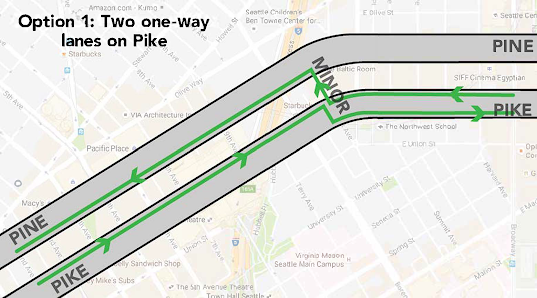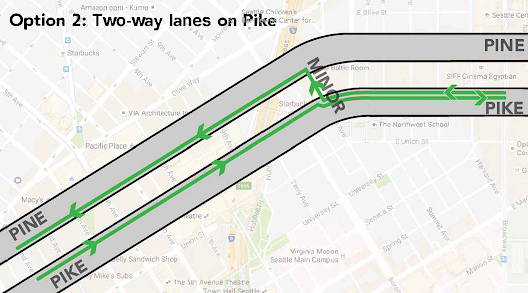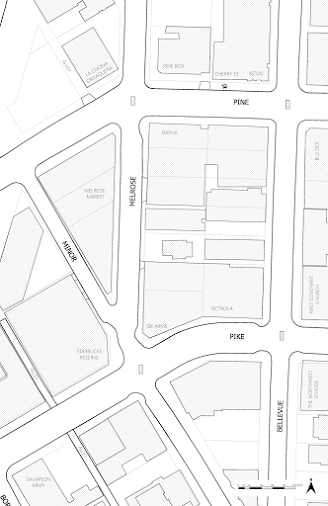Few bike improvements in the city could have a bigger impact than a safe, comfortable and fully connected bike route from the Pike Place Market to Broadway. And due to the grade of First and Capitol Hills as well as I-5 cutting off many streets, Pike and/or Pine are the only options to make this connection.
These streets are already very popular for people on bikes despite their insufficient or lacking bike lanes because they are the only real choices for people living in large swaths of Capitol Hill, First Hill and the Central District. Being packed with destinations helps, too. Since most people have no interest in biking mixed with car traffic, connecting 2nd Ave’s protected bike lanes to the Broadway bikeway has enormous potential to connect a lot of homes, businesses and destinations.
More than 150 people attended a late October community workshop organized by Seattle Neighborhood Greenways, Capitol Hill Housing and the Capitol Hill EcoDistrict. They provided a lot of feedback on the city’s effort to complete this connection by the end of next year. But the organizers want to make sure the opinions of folks who couldn’t attend are also included, so they put together an online survey.
After considering the realistic options, organizers determined that the lanes will most likely go both ways on Pike Street from Broadway to around Melrose, then switch to westbound on Pine and eastbound on Pike through downtown as outlined in the Pike Pine Renaissance plan.
The first major question is about the basic design of bike lanes on Pike from Broadway to the street curve near Minor. Should they be one-way bike lanes on each side of the street or a two-way bike lane on the north side of the street?
The second question is about the transition where the streets curve near Minor. Which street is the best option for routing people headed westbound over to Pine Street? Minor, Melrose and Bellevue are pretty much the options available.
Reconsidering the Pine Street bike lane
The existing bike lane on Pine Street downtown, installed a year ago, is terrible. There’s just no way to sugar coat that. Forcing people biking to mix with car traffic through the brick section near Westlake Park ruins this bike connection. The Pike Pine Renaissance plan depicts this bike lane remaining in its current flawed state, but this does not achieve the basic goals of a protected bike lane connection. A route is only as comfortable as its most stressful section, and mixing with car traffic through the brick section pretty much negates the benefits of the bike lane on the other blocks.
So while this survey does not address this issue, the city needs to make a choice. Are we going to redesign the brick section to create a continually-protected bike lane on Pine? Or do we need to move the westbound bike lane to Pike Street? Either option could work, but we must do one of them.
One possibly great option would be a two-way bike lane on the north side of Pike Street from Pike Place Market to Broadway. This would definitely be the most intuitive route because it is consistent and direct the whole way. In fact, a lot of people already treat the Pike Street bike lane as a two-way today, suggesting the demand is there. This option would also have basically no transit conflicts.
SDOT could then remove the flawed Pine Street bike lane downtown, but they should keep the pre-existing painted bike lanes on Pine Street east of 8th Ave for the sake of business access and because there’s no benefit to getting rid of them. I imagine that even with a quality bike lane on Pike, some confident riders will still choose to bomb down Pine Street because it is just so fast if you feel comfortable mixing with car traffic. People who want to go fast downhill might not like riding in a two-way bike lane. And that’s OK. Having choices is a good thing.
More details about the survey from the community organizers:
We were thrilled that more than 150 community members representing a range of perspectives joined us on October 25th at the Pike/Pine Protected Bike Lane Community Design Workshop to share their thoughts on street design. Even better, we heard from many that this community-driven model should be adopted by the City for all major projects. We will share our lessons learned in the hopes of making that possible.
We heard you. As we assemble our analysis, key themes have emerged. Participants expressed the importance of safety for all users, of clearly marked and logical bike routes, of plentiful loading zones for freight and for people, and the challenge of balancing competing needs.
See group-designed maps and suggestions as well as photos from the workshop.
Next Steps
To ensure that as many community members as possible have the opportunity to provide feedback, we will continue direct outreach through the end of December. In January, we will share our summary findings with the Seattle City Council, SDOT staff, and you!Take our survey to share your thoughts on bike lane location and how to balance other uses of the street. We’ll include your comments in our advocacy and share them with City planners and officials. Share the survey with anyone you think might be interested!











Comments
16 responses to “Take this Pike/Pine bike lane survey + Rethinking Pine St downtown”
Where is the link to the actual survey? I can’t locate it in the article.
Oops. Fixed it.
Thanks, done!
There doesn’t seem to be a link to the survey?
Here it is: https://pblworkshop.splashthat.com/
Good news they plan on completing a solution by the end of 2019 !
Frankly, I don’t think either solution is good enough. Having to jog over a block mid trip is something I would expect for a temporary solution, not a permanent one.
Here are some considerations:
1. Battery EV buses will, in the relatively near future, will replace all the existing fleet. These are under test now. With EV buses, no trolley wires are needed and moving a trolley bus route becomes much easier.
2. The contraflow bike lane (northbound) on 2nd doesn’t work as well as it could, due to signal timing. Basically, you can ride for two blocks at time, arriving exactly when the light turns red. Basically doubles the ride time. While the bike lane is still useful, it could be a lot better.
3. Dual bike tracks are hard to enter an exit. With a single lane, you can move into the traffic lane if you need to, or vice versa. Similarly, if you’re stuck behind a slow rider, it’s easier to get around if there’s only bike lane to contend with.
Considering the above, we have the opportunity to do much better, I think. Keep westbound on Pine for the full length, eastbound on Pike for the full length.
I realize that the bike lanes don’t have to work for everyone. But why not make them work as well as possible?
I generally dislike two-way bike lanes as some bikes move opposite the way traffic is flowing. Drivers adjacent to the bike lanes look for other cars when making turns. No one looks for bikes coming the “wrong” direction.
This might be better on Pike as it’s a one-way street. I’ve never biked Pike–I avoid downtown Seattle–so I don’t know. Is a two-way bike lane really a good design?
Two-way bike lanes should never exist in an urban environment and most of the cities where they were installed are quickly removing them (i.e. Chicago) due to the high collision rates. The only reason we have them is because of the incompetence of Kubly (who was also responsible for Chicago).
A few main issues
– They are extremely expensive to install (correctly) as they require new signals at intersections, signage and cross-over connections to other roads where the lanes end. This eats up bike/ped budgets and leads to headlines like “Seattle bike lanes cost $12 million per mile,” which ultimately leads to reduced overall investments in bike facilities.
– They are extremely dangerous as it’s not intuitive for drivers (cars, delivery trucks, and buses) to look for contra-flow cyclists in the lane when the are turning, they encourage dangerous behavior to access the lanes, and they significantly reduce the visibility of pedestrians waiting to cross the road as they are set back by 10+ feet from the crosswalk.
– They cause delays for everyone as they add an additional light cycle at intersections.
– Hardly anyone uses them (see above reasons) which is clear in the counts on existing facilities, which creates bikelash from the community as they wonder why we are taking badly needed surface street space for bike lanes that often appear to be completely empty. Also note most of the existing facilities are short and have no connectivity with other bike infrastructure (another big pat on the back for Kubly).
Two-way bike lanes should only be used on trails and other facilities with very limited interaction with vehicles.
awesome note from southeasterner
I agree with Peri and AP that the two-way bike lane concept is the worst option and that the best option not presented would be to just make a one-way bike lane on Pike going East and a one-way bike lane on Pine going West. Two-way bike lanes, especially on sloped streets like these, are somehow both slower and more dangerous.
Why should cyclists have to navigate an additional intersection, make two unnecessary turns, including a left, to make a straight shot downtown? The answer is they shouldn’t. This is not Vision Zero and doesn’t need to be this complicated.
I have made the same suggestion as Tom. We should not assume the Pike-Pine Renaissance plan. They did not consider transit well and assumed the CCC Streetcar that may and should be killed. Transit service should be on Pine Street near to Westlake Station for short transfer walks. there is two-way trolley bus overhead on Pine Street east of 8th Avenue and none on Pike Street east of Bellevue Avenue. The Renaissance ignored that factor. The bike facilities should be on Pike Street to minimize the friction between those two modes. My table at the work shop correctly suggested that the Pike Street bike lanes should be one-way on either side of the arterial due to grades. there will be significant speed differential and riders will want to safely pass one another. Tom is correct that the current Pine Street PBL meets a curb bulb at 5th Avenue. In downtown, where the grade is less steep, a two-way cycle track might be installed on Pike Street; some curb bulbs and parking may have to be foregone.
Peri overstates the role of battery bus. They are only in the testing stage. They could replace hybrid buses, if they prove efficient. The trolley bus could be in Seattle indefinitely. we should love using clean quite traction power that climbs hills well and that attracts federal funds.
the Pike Street infrastructure needs to deal with the flow of hybrid buses to I-5 via the reversible ramp at 9th Avenue until 2021 and Northgate Link.
some riders may continue to use Pine Street even without bike infrastructure. many of us have been carefully biking without infrastructure for decades. I hope the Pike Street marking extend east to 12th Avenue and those bike lanes; 12th Avenue has topographical advantage for through trips.
The workshop organizers and representatives from SDOT and Metro all stressed that the trolley wire could not be moved to Pike, preventing a one-way couplet scenario (what seems obvious as the easiest to use and understand for all users). However they did not mention that there is only ONE bus route that still uses trolley wire through Pike/Pine east of Bellevue. That route, the 49, runs on trolley wire from downtown to Broadway to the U district, meaning its major service points are duplicated (or will be shortly) by light rail. There is a large stretch of Broadway that is only served by the 49, whose residents would likely prefer the quieter electric bus, but the 11 already duplicates the Pike/Pine portion of the route with a diesel bus.
Long term planning for the future of one of the most dense neighborhoods in the city should not be constrained by the transportation technology of 100 years ago. There are options that could be cost effective and transformative for both the bike and transit networks, but unfortunately, SDOT and Metro are being very short-sighted, and staying in their silos as much as possible.
If you look at the long range plans for bus service (http://www.kcmetrovision.org/wp-content/themes/kcmlrtp/LongRangePlan/#) you can see that Metro wants to alter the 49 to run towards Beacon Hill, not downtown. These plans should not be considered an actual proposal, but more a set of ideas. In any case, it is reasonable to assume that the 49 will not run towards downtown.
However, it isn’t the only trolley bus that runs on Pike/Pine. The 10 also runs there. The 10 is basically unchanged in their long range plans. They also want to move the 2 over to Pike/Pine when Madison BRT comes online. That would require a minimal amount of new wire (two blocks). Basically, the long range plans are for trolley buses to run on Pike/Pine indefinitely (until at least 2040). There would be other buses along Pike/Pine, but they would be less frequent.
One thing I would love to see is a contra-flow bike lane on Pine between 7th and 8th. It seems like such a missed opportunity that from the protected bike lane on 7th, you are just one block of a one-way-the-other-way street away from an eastbound lane on Pine taking you up the hill. Usually I end up just riding a block on the sidewalk (not ideal) or taking Virginia to 9th to Pine (construction nightmare), but that one block gap drives me nuts!
I like the contraflow idea a lot. There are some big advantages to contraflow bike lanes. First, they never deal with other traffic going the same way. This means buses and parked cars are not an issue. Second, they are probably the safest bike lane option. Driving is intuitive. The only danger are drivers taking a left, and then it is just like most left turns (except that the oncoming traffic is all just bikes).
The only disadvantage is that it isn’t easy to pass someone. You can’t mix with traffic, as you would with a right side bike lane. But it still isn’t impossible (you just pass a bike the same way a car would pass a car on a two lane road). In this case, I don’t see at as being an issue. There are two situations where I think this can be a problem. One is if you are going a really long distance (which simply isn’t the case here). The other is when someone is going very slow, which is only likely to happen while going up the hill. In this case that really isn’t an issue, as the street starts getting steep only after it becomes two way. Either way, for aggressive bikers, I think this is safer. At least you can see all the traffic you are going to encounter, as opposed to a typical bike lane situation, where you need to merge, and have to look over your shoulder.
I think it would make a lot of sense to just have contraflow bike lanes which transition to right side bike lanes on both Pike and Pine the whole way. That means Pine is eastbound, while Pike is westbound (all the way up the hill).
Two way bike lanes on a hill are a terrible idea. When I commuted into downtown from the Eastside, I rode over Capital Hill on 16th, which picks up Pine at the top of the hill nicely, then it was a quick trip straight down the hill. Going home, it was a slow grind up Pike on the right side of the street. I can’t imagine having riders come at me at the speed we all descended at. I’d rather be in traffic.